Nail
 From Nwe
From Nwe 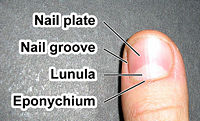
In anatomy, a nail is a horny epidermal derivative that covers the dorsal tip of the fingers and toes of humans and most primates, and consists of a flattened, slightly curved translucent plate of the protein keratin that forms largely from dividing cells in the base, and attaches to and slides over a nail bed. In humans, nails are the largest skin appendages (Haneke 2006). Human and primate nails are homologous to vertebrate claws and hooves, and made of the same protein (keratin) found in hair, skin, and horns.
In addition to revealing a unity with other vertebrates, and support for the view that more recent creations come on the foundation of earlier forms, fingernails also are more practical for tool-wielding (and keyboard typing) humans. Beyond this, they are important culturally and aesthetically, as decoration of fingernails and toenails dates at least as far back as Ancient Egypt (Blakemore and Jennett 2001).
Parts of the nail unit
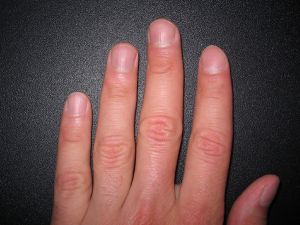
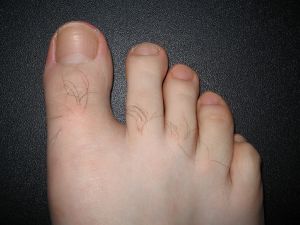
The nail unit, for both fingernails and toenails, is made up of several different structures (Levit and Boissy 2001; ND 2005):
- Germinal matrix or nail root. Much of this is under the nail fold at the base of the nail plate and thus is not seen, although the distal end is seen in most people as represented by the distal end of the lunula. The germinal matrix is formed from thick epithelium and consists of mostly matrix cells, which differentiate into the nail plate.
- Nail plate. This is the hard, translucent, flattened portion, composed of keratin, with the proximal area white (lunula), the middle portion firmly adhering to and sliding over the nail bed, and the distal portion as the free edge.
- Lunula. This is the whitish, half-moon or crescent shape structure visible in the human thumb and big toe.
- Free edge. The free edge is the part of the nail plate that extends past the finger, which is no longer attached to the nail bed.
- Nail bed. The nail bed is the adherent connective tissue that underlies the nail plate, often colloquially referred to as the "quick." The nail plate adheres to this bed and flows over it.
- Nail fold. This is the skin that on the three sides of the nail that frames the nail.
- Nail frame (perionychium). The perionychium or paronychial edge is the tissue of the finger or toe that overlies the nail plate on the sides.
- Cuticle (eponychium). The eponychium or cuticle is the fold of tissue at the proximal end of the nail, connecting the skin and the nail plate, and overlapping the nail plate at the base of the nail, providing a waterproof barrier.
- Hyponychium. This is the attachment between the skin of the finger or toe and the distal end of the nail, which also provides a waterproof barrier.
In common usage the word nail usually refers to the nail plate only.
Nail growth
The growth of the nail plate begins in the germinal matrix' or nail root. The matrix is about four to nine millimeters long in humans, with most under the nail fold (Levit and Boissy 2001). The distal end is visible in most people as the lunula, particularly in the thumbs and big toes. Consisting mostly of matrix cells, the matrix gives rise to the nail plate and the nail bed.
The nail plate is composed of "closely packed, fully keratinized, multilayered lamellae of cornified cells" (Levit and Boissy 2001). Keratins are a family of fibrous structural proteins; tough and insoluble, they form the hard but non-mineralized structures found in reptiles, birds, amphibians, and mammals. Cells in the epidermis contain a structural matrix of keratin. As certain skin cells differentiate and become cornified, pre-keratin polypeptides are incorporated into intermediate filaments. Eventually the nucleus and cytoplasmic organelles disappear, metabolism ceases, and cells undergo a programmed death as they become fully keratinized. Hard structures are formed by intercellular cementing of fibers formed from the dead, cornified cells.
The nail matrix cells differentiate and create the nail plate by flattening, broadening, and by nuclear fragmentation, with an accumulation of cytoplasmic microfibrils (Levit and Boissy 2001). The keratins in the nail plate are believed to be held in place by surrounding globular matrix proteins with a high concentration of disulfide bonds between cystine (rather than by means of calcium, as in bones), creating the rigid structure (Levit and Boissy 2001).
In humans, the nail plate is about 0.6 millimeters to one millimeter in thickness (Levit and Boissy 2001). It is dorsally smooth. The nail bed adheres tightly to the ventral surface of the nail plate and slides along the nail plate via longitudinal folds and grooves formed by a nail bed horny layer.
As the matrix cells grow, the nail plate is pushed out toward the free edge. In addition, Johnson and Shuster (1993) report that the nail is formed continuously along the nail bed as well as by the germinal matrix, noting in their study that approximately 79 percent of the nail thickness was contributed by the nail matrix and 21 percent by the nail bed.
Levit and Boissy (2001) report that the nail plate of human fingernails grows at an average rate of 0.1 mm per day, with toenail growth one half of that rate. Fingernails require three to six months to regrow completely, while toenails require 12 to 18 months. The actual growth rate is dependent upon such factors as age, season, exercise level, and hereditary factors. And contrary to popular belief, they do not continue to grow after death; the skin dehydrates and tightens, giving the illusion that the nails grow.
Health and care
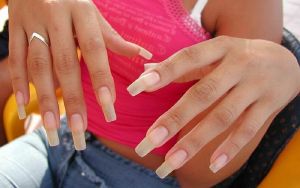
The growth record of fingernails can show the history of recent health and physiological imbalances, and has been used as a diagnostic tool since ancient times. Major illness will cause a deep groove to form across the nails. Mis-coloration, thinning, thickening, brittleness, splitting, grooves, Mees' lines, small white spots, receded lunula, clubbing (convex), flatness, spooning (concave) can indicate illness in other areas of the body, nutrient deficiencies, drug reaction or poisoning, or merely local injury. Nails can also become thickened (onychogryphosis), loosened (onycholysis), infected with fungus (onychomycosis) or degenerative (onychodystrophy). Nails can dry out, just like skin. In fact, Johnson and Shuster (1993) found that typical nail water content was constant at nine to ten percent along the nail length.
Manicures and pedicures are health and cosmetic procedures to groom, trim, and paint the nails and manage callouses. They require various tools such as cuticle scissors, nail scissors, nail clippers, and nail files.
Nail tools used by different people may transmit infections.
Biting the nails often indicates internal tension, stress, boredom, hunger, or it may simply be a habit. Nail biting can result in the transportation of germs that are buried under the surface of the nail into the mouth. It may also cause excessive or abnormal wear of tooth enamel.
Culture
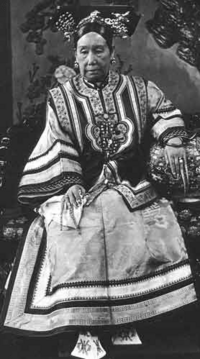
Nail decoration for aesthetic purposes, for both fingernails and toenails, dates to at least Ancient Egypt (Blakemore and Jennett (2001).
In modern western culture, long nails are a symbol of femininity, while short nails are a symbol of masculinity. However, in some Asian cultures, men may also grow long fingernails, or only the nail on the little finger, to show that they do not do much manual labor, but instead work in an office setting. In Chinese and Hindu cultures, growing long fingernails has been a traditional practice, as a sign of leisure and status, since it is difficult to practice manual labor with long fingernails (Blakemore and Jennett 2001). In the nineteenth century in the Balkans, white-collar workers, such as clerks, grew their fingernails long to distinguish them from people in lower classes who worked with their hands (Mckay 1983).
Some guitar players, notably classical and fingerstyle players, will purposely grow long nails on the hand they use to pluck the strings. Their longer nails serve as small, easily-maneuverable guitar picks. For some serious musicians, daily nail care can become a mark of pride and dedication.
In comparison, pianists must keep their nails trimmed short to avoid clicking noises on the keys and avoid dangerous situations where in fast passages the nail may be caught under a key and rip off, and most string players, such as violinists and guitarists, must keep at least the nails on their fretting hand short to allow the strings to be fingered correctly.
Painting the nails with nail polish (also known as nail lacquer) is a common practice dating back to at least 3000 B.C.E. Nail decoration is usually limited to females. Colored and clear nail polish or enamel became popular in the early twentieth century for women (Blakemore and Jennett 2001). Ornamented fake nails are sometimes used to display designs, such as stars or sparkles, on nails. They are also used to make nails look longer.
References
ISBN links support NWE through referral fees
- American Academy of Dermatology. 2006. Nail fungus and nail health American Academy of Dermatology. Retrieved December 31, 2007.
- Blakemore, C., and S. Jennett. 2001. The Oxford Companion to the Body. New York: Oxford University Press. ISBN 019852403X.
- Haneke, E. 2006. Surgical anatomy of the nail apparatus. Dermatol Clin 24(3): 291-296. PMID 16798426
- Haneke, E. 2006. Onychocosmeceuticals. Journal of Cosmetic Dermatology 5(1): 95-100.
- Johnson, M., and S. Shuster. 1993. Continuous formation of nail along the bed. British Journal of Dermatology 128(3): 277-280.
- Levit, E. K., and R. E. Boissy, R. E. 2001. Chapter 6. Basic science of the nail unit. In R. K. Freinkel, and D. T. Woodley. The Biology of the Skin. New York: Parthenon Pub. Group. ISBN 1850700060.
- McKay, J. P., B. D. Hill, and J. Buckler. 1983. A History of Western Society. Boston: Houghton Mifflin Co. ISBN 0395328047.
- MedicineNet. 2007. Toenail MedicineNet.com. Retrieved December 31, 2007.
Skin • Sweat glands • Sebaceous glands • Hair (Hair follicle) • Nails
Skin
Epidermis (Stratum corneum, Stratum lucidum, Stratum granulosum, Stratum spinosum, Stratum germinativum/basale)
Dermis • Subcutis
Credits
New World Encyclopedia writers and editors rewrote and completed the Wikipedia article in accordance with New World Encyclopedia standards. This article abides by terms of the Creative Commons CC-by-sa 3.0 License (CC-by-sa), which may be used and disseminated with proper attribution. Credit is due under the terms of this license that can reference both the New World Encyclopedia contributors and the selfless volunteer contributors of the Wikimedia Foundation. To cite this article click here for a list of acceptable citing formats.The history of earlier contributions by wikipedians is accessible to researchers here:
- Nail_(anatomy) history
- Keratin history
The history of this article since it was imported to New World Encyclopedia:
- History of "Nail"
Note: Some restrictions may apply to use of individual images which are separately licensed.
↧ Download as ZWI file | Last modified: 02/04/2023 10:52:57 | 97 views
☰ Source: https://www.newworldencyclopedia.org/entry/Nail_(anatomy) | License: CC BY-SA 3.0
 ZWI signed:
ZWI signed: KSF
KSF